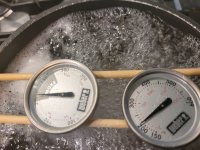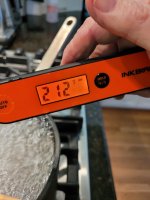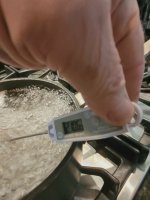MichaelBratton
New member
Seeing so much here and on YouTube about the inaccuracy of the Weber thermometers I was preparing to purchase replacements for my WSM and Weber kettle. Before doing so I decided to do a little test with them along with the Thermoworks and Inkbird instant thermometers I have.
I'm pretty glad I did because as you can see in the photos they are just about spot on. At least close enough for what I do.
At my location the altitude and barometric pressure read that I should be at about 211.6° F. I have never had a problem seeing them as I am usually close enough to them when I need to. Both of these Weber thermometers are 2021 model year.


I'm pretty glad I did because as you can see in the photos they are just about spot on. At least close enough for what I do.
At my location the altitude and barometric pressure read that I should be at about 211.6° F. I have never had a problem seeing them as I am usually close enough to them when I need to. Both of these Weber thermometers are 2021 model year.



Last edited:
